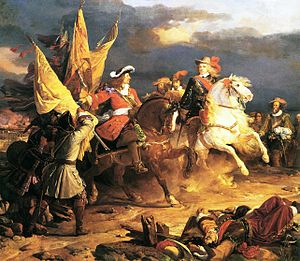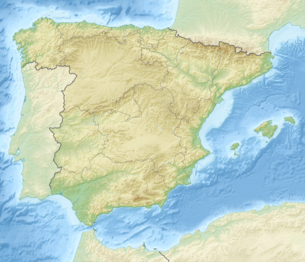
Back Batalla de Villaviciosa AN Вила Висиоса (битка) Bulgarian Emgann Villaviciosa (1710) Breton Batalla de Villaviciosa de Tajuña Catalan Schlacht bei Villaviciosa German Batalla de Villaviciosa (1710) Spanish Bataille de Villaviciosa (1710) French Battaglia di Villaviciosa (1710) Italian ビリャビシオーサの戦い Japanese 비야비시오사 전투 Korean
| Battle of Villaviciosa | |||||||
|---|---|---|---|---|---|---|---|
| Part of the War of the Spanish Succession | |||||||
 Vendôme (left) presents the standards to Philip V of Spain (right) at Villaviciosa by Jean Alaux. | |||||||
| |||||||
| Belligerents | |||||||
|
|
| ||||||
| Commanders and leaders | |||||||
|
|
| ||||||
| Strength | |||||||
| 20,000[2] | 14,000[2] | ||||||
| Casualties and losses | |||||||
| 2,000–3,000 dead or wounded |
5,000–6,000 dead or wounded 3,000 captured | ||||||
The Battle of Villaviciosa (11 December 1710) was a battle between a Franco-Spanish army led by Louis Joseph, Duke of Vendôme and Philip V of Spain[2] and a Habsburg-allied army commanded by Austrian Guido Starhemberg. The battle took place during the War of the Spanish Succession,[2] one day after a Franco-Spanish victory at Brihuega against a British army under James Stanhope, 1st Earl Stanhope.[2][3] Both Philip V of Spain and the Archduke Charles of Austria claimed victory, but the number of dead and wounded, the number of artillery and other weapons abandoned by the Allied army and the battle's strategic consequences for the war confirmed victory for Philip.[2]
The battle was largely determined by the Spanish dragoons commanded by the Marquis of Valdecañas and the Count of Aguilar,[4] which far exceeded the opposing forces.[2] The Austrian forces retreated, pursued by Spanish cavalry,[2][4] and the allied army was reduced to 6,000 or 7,000 men[2] when it reached Barcelona (one of the few places in Spain still recognizing Charles' authority) on 6 January.[2]
